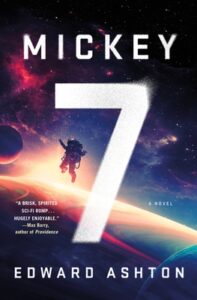One of the knocks on science fiction is that it’s a literature focused on ideas rather than people. While it’s true that at the heart of every science fiction story there’s a key conceit, it’s not necessarily true that this has to be the focus of the action. In many cases, it’s more like an undercurrent adding flavor to a piece that could otherwise almost be contemporary fiction. My newest book, Mickey7, is much more the latter than the former. Sure, it’s set a thousand years in the future, but despite that it’s at least as much about character and plot as it is about the science.
Still, though, Mickey7 is science fiction, and the idea is there. Specifically, this book’s narrator, Mickey Barnes, is living through the teletransport paradox (more commonly referred to as the transporter problem), a philosophical question that better thinkers than me have been chewing over since 1775. Its essence is this: suppose that somehow we could produce an exact copy of you, both physically and mentally, that we could imbue the copy with all of your memories, your hopes and dreams, your love of dark chocolate and your hatred of EDM—would the copy actually be you? Or would it be a completely separate person who just happens to look like you and talk like you and spend his days getting his grubby hands all over your stuff? More importantly, now that you know that this other you is hanging around in the world, would you be okay with dying?
As I said, I’m far from the first person to think about this question. Here are a few others stories in this space that you might want to give a look:
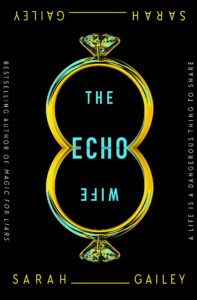
The Echo Wife, by Sarah Gailey
In The Echo Wife, Gailey adds a twist to the classic teletransport paradox: rather than asking whether it would be okay to die and let your double replace you, this book wonders whether it would be okay to go on living while your double marries your ex.
More specifically, Gailey gives us a narrator who is the world’s leading expert in the burgeoning field of producing and then murdering clones. She’s brilliant, but she’s also deeply emotionally damaged by childhood trauma that is revealed to the reader in a slow drip as the novel progresses. She’s also recently divorced from her charming but much less accomplished and low-key parasitic husband. The divorce, we learn early on, came about because our narrator discovered that her husband has been conducting an affair. A few chapters in, we also learn that his new partner is the narrator’s clone, who was created by the husband using his wife’s pioneering techniques and a stolen sample of her DNA.
I don’t want to spoil any of Gailey’s twists (there are many of them) but I will say that what could have been the story of a bizarre love triangle turns instead into a deep examination of the way trauma marks us, and the way we manage to find kinship and solidarity in the most unlikely places.

Kiln People, by David Brin
Brin is probably best known for the Uplift series, but this 2002 stand-alone novel is some of his best work. Kiln People is basically a crime noir with replicants. It’s set in a future where people routinely produce temporary copies of themselves to handle all the parts of their lives that they’d rather not deal with. These copies (Brin calls them “dittos”) fall apart physically after only a day or two, at which point they ideally merge their memories back into the brain of their original.
The book’s protagonists are a private investigator who uses dittos to handle most of the dangerous parts of his job, and one of his dittos who decides he wants to spend the few hours of life he’s been granted doing something a little more meaningful than carrying out his original’s scutwork. The plot hits all the high points of a standard P.I. pulp novel in an entertaining way, but to me the fun part is the way Brin wrestles with the morality of creating armies of sentient creatures whose only hope in life is to live long enough to contribute a few memories back to their creators.
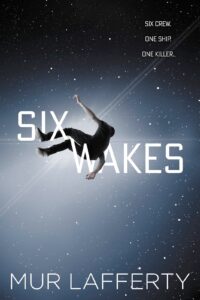
Six Wakes, by Mur Lafferty
It’s probably a lucky thing that I didn’t read this book until after I’d finished writing Mickey7, because Six Wakes begins in a very similar place—clones, mind-mapping, immortality, an interstellar colonization mission—but then takes off in a wildly different direction. The first thing that became apparent to me when I started into this book was that, unlike me, Mur Lafferty seemingly has no interest whatsoever in the ol’ teletransport paradox. In this book’s world, it’s taken as a given that your clone is a straightforward continuation of you. People who employ cloning for life extension have no fear of death, to the point that one prominent character allows herself to be assassinated just to seal a business deal. The thought that the clone who comes out of the tank the next day might actually be an entirely separate person has apparently never occurred to any of them.
What Lafferty is interested in is an amazingly baroque murder mystery. The book opens on a scene of carnage. The crew of a colony ship wakes from their cloning vats to find their most recent incarnations gruesomely slaughtered. Complicating things, their memories are twenty-five years out of date, so that even the actual killer has no real idea who did it, or why. What follows is a slow, head-hopping reveal of the crew’s sketchy pasts and legitimately murderous motivations, and the seemingly coincidental ways the six crew-members’ histories have intertwined over the courses of their many lives. Six Wakes is the sort of book I never could have written—just the thought of trying to diagram out all the plot twists in this one makes my head hurt—but it’s one I’m very glad to have had the chance to read.

Dark Sky Legion, by William Barton
This one wins an award for most weirdly horny cover art, and like much of Barton’s work it includes a fair amount of moderately cringe-inducing focus on the female form, but it does have some interesting concepts on the replicant front. Dark Sky Legion imagines a future in which humans are spread across the galaxy in a polity called the Metastable Order, all of which is ruled from Earth. Because all interstellar travel is slower than light, though, it’s a bit difficult for the rulers to actually… you know… rule. So, they’ve established a system in which enforcers known as Televoxes visit the planets of the Order every few hundred years or so, just to make sure everyone is still doing what their pals back on Earth want them to do. If they’re not, the Televox is empowered to take steps ranging from overthrowing the local government to obliterating the planet entirely.
The trick here is that because it takes decades or longer to reach the average colony world from Earth, the Televox travels as a recorded data file, only to be re-embodied when they reach their destination—kind of like traveling by transporter beam, except that the information is transported on a slow boat rather than at light speed. In Dark Sky Legion, a Televox named Maaron Denthurion arrives at his designated colony to find a whole lot of weirdness going on, and has to decide whether or not to wipe the place clean. I won’t spoil the ending, except to say that it was… not what I expected. If you can tolerate a certain amount of male-gazeiness, this one is definitely worth a look.
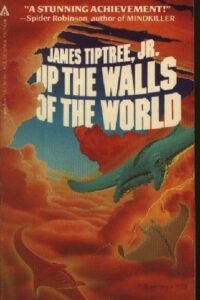
Up the Walls of the World, by James Tiptree, Jr.
James Tiptree, Jr. (aka Alice Sheldon) was primarily known for her shorter works, which heavily feature vivid and imaginative world building and impossible moral dilemmas. Up the Walls of the World is probably the best-known of her short list of novels, and it has both of those qualities in spades. I first read this book when I was ten or eleven years old, and it’s one of three or four stories that I’d credit with first sparking the interest in science fiction that’s held on to me ever since. This novel doesn’t deal with clones per se, but it does heavily feature body-snatching and transfer of consciousness, which I think is sufficiently clone-adjacent to squeeze it onto this list.
Up the Walls of the World is mostly set on an alien planet whose sun is flaring towards supernova. The natives of this planet don’t have space travel, but they do have immense psychic powers, including the ability to project their consciousness into another body, and in the process pull that body’s consciousness into their own. Doing this to an unwilling host is lifecrime, a morally abhorrent act—but their planet is dying, and lifecrime against the inhabitants of another world is their only hope of escape.
As you’ve probably already guessed, the world where they find the possibility of refuge is Earth—in particular, they stumble upon a collection of misfits who have been brought together by the CIA in a secret program examining the military applications of psychic powers. I know this sounds like the setup for a standard alien invasion story, but Sheldon does such a masterful job of conveying the beauty of the alien world, its inhabitants and their culture, that in this one you quickly find yourself rooting for the invaders.
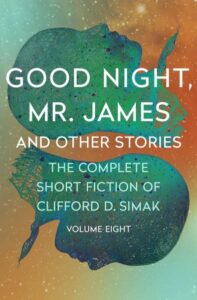
Good Night, Mr. James, by Clifford D. Simak
This one is a deep cut, first published in 1951. It begins as what feels like a typical adventure story, with a protagonist tasked with hunting down a dangerous alien that has escaped from an illegal collection and threatens all life on Earth if it’s able to reproduce. You may begin to question whether that’s really all there is to this, however, when he finally manages to kill the creature and you’re only half-way through. At that point, both the reader and our hero begins to realize that something is a bit off. Eventually, it becomes clear that he’s actually a replicant, sent on this mission because his original, who’s the one responsible for the creature getting loose in the first place, was too cowardly to do the job himself. Replicants are illegal and are routinely killed as soon as they’ve served their purpose, so his only hope is to find his original, kill him, and take over his life. The story ends with a fun but decidedly dark twist. I first read this piece when I was a child. It’s stuck with me ever since. Highly recommended.

Never Let Me Go, by Kazuo Ishiguro
This is by a large margin the most well-known book on this list, and there’s not much to say about it that hasn’t already been said. Never Let Me Go is a coming of age story whose protagonists are clones being raised solely to serve as organ donors for their progenitors—in other words, a coming of age story for those who will never truly be permitted to come of age. As a result, the characters spend much of the book trying to find hope and meaning in a life that is essentially, deliberately devoid of both. This book is brilliant and heartbreaking in equal measure, and just on the off chance that you haven’t read it yet, please take me at my word when I say that you really, really should.

The Ophiuchi Hotline, by John Varley
This book is the first of four novels and a great number of short stories set in Varley’s Eight Worlds universe. This one hits the morality questions surrounding replicants from a few different directions. One of the earliest plot points has the protagonist, Lilo, escaping her own (justified) execution by creating an illegal copy of herself and allowing the copy to be executed in her place. Executions on Luna at this time are carried out by dropping the condemned into a micro black hole, and Varley vividly describes the replicant’s terror and bewilderment as she’s shredded by tidal forces and then destroyed. By the end of the book Lilo has died and been reborn multiple times, ultimately splitting off into multiple independent iterations, one of whom is on her way out of the solar system. Earlier, as Lilo was repeatedly killed and then resurrected, it seemed that the replicants were truly continuations of the original Lilo’s life. By then end, however, it’s pretty clear that this was a fantasy, that the original Lilo is long dead and her current iterations are entirely separate entities.
There’s a ton of other stuff in this book, which covers everything from the essential mutability of gender to the importance of being nice to whales. If you’re only going to read one book this year involving someone getting chucked into a black hole for making a new type of food called “bananameat” out of human DNA, this should definitely be the one.
***


